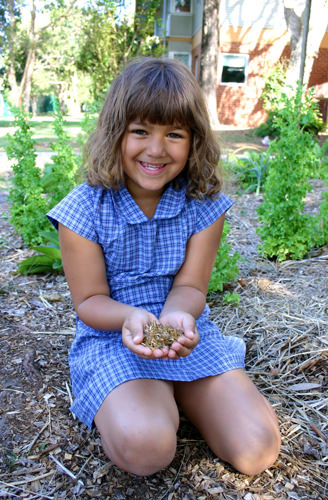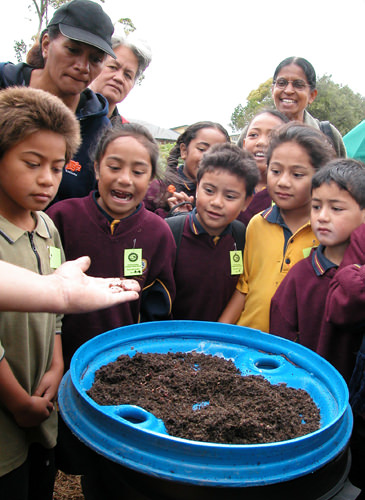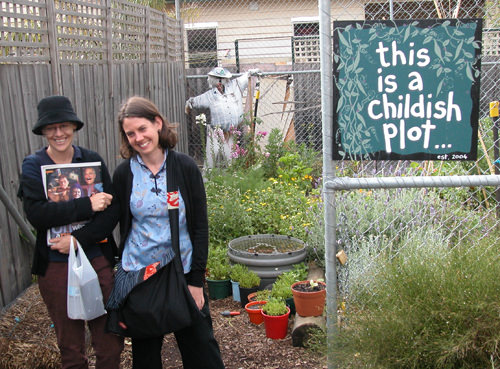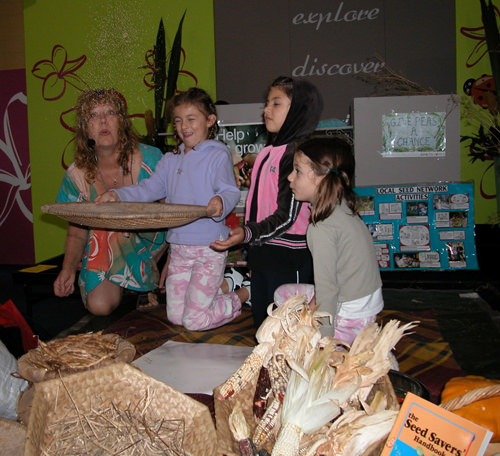 Schools are excellent places for creating food gardens as they often have more space than homes.
Schools are excellent places for creating food gardens as they often have more space than homes.
As ‘outside classrooms’, school food gardens can be used for a range of activities across all curricula.
They provide a great opportunity for physical exercise and hands-on, experiential learning. Gardening can be a magical experience for children.
They love to help out and delight at ripening berries, blooming sunflowers, and gathering up lemons for lemonade.
Most adults can recall happy times spent in the garden when young, learning how to plant seeds and stake tomatoes, an experience often shared with our parents and grandparents.
Many of us remember the exquisite taste of homegrown food – in contrast to the bland taste of many supermarket fruits and vegetables today.
Unfortunately, with the trend towards shrinking backyards and increasingly busy lives, domestic food gardens have become a thing of the past.
The opportunity to pass on important gardening skills from generation to generation and to share in the joys of homegrown food is being lost.

For children without a vegetable patch, or even a fruit tree, there’s little opportunity to observe how food grows.
They may only ever see fruit and vegetables at the supermarket where they come neatly packaged, bear little resemblance to the whole plant and may be sold outside the normal growing season.
With this in mind we wrote and published Seed to Seed Food Gardens in Schools a 100 page book on how to design, establish, maintain and use a food garden in an educational institution. We hope to inspire a rebirth of food gardens so children will be able to enjoy gardening and growing their own food and their own seed for the next season.
Principles of seed to seed food gardens
 This book recommends establishing a seed to seed food garden with four fundamental principles in mind:
This book recommends establishing a seed to seed food garden with four fundamental principles in mind:
· Low input and organic gardening methods
· Respect for the entire life cycle of the plant
· Sustainable water use
· Maintaining biodiversity
In a seed to seed food garden children are encouraged to be resourceful by using what’s around them to create low input and low maintenance gardens. This approach provides the opportunity to think creatively and teaches the importance of treading lightly on the earth.
A commitment of time is also required to establish an abundant food garden. You’ll need a minimum of at least a year to ensure there’s plenty of time to collect, grow and re-sow seeds. Once the garden is established it may become a permanent feature as its many benefits are experienced.
Seeds are central to a food garden. Rather than starting with shop bought seedlings, we grow from seed to seed. Children learn the skills needed to sow and save seeds, which helps them to develop an understanding and appreciation for the entire life cycle of the plant.
 Seed to seed gardening teaches self-sufficiency and reaffirms the abundance that is available from seeds. Growing from seed also gives children the opportunity to interact with the seasons and to experience the excitement of sprouting and harvesting seeds.
Seed to seed gardening teaches self-sufficiency and reaffirms the abundance that is available from seeds. Growing from seed also gives children the opportunity to interact with the seasons and to experience the excitement of sprouting and harvesting seeds.
Collaboration is the key to a successful school food garden.
The process of planning and creating the garden provides an opportunity for the whole school community to work together to foster a sense of care and involvement toward the garden. A variety of techniques for designing, making, maintaining and utilising a food garden are detailed in the chapters of Seed to Seed Food Gardens in Schools.
Five good reasons for creating a school food garden
There’s a great deal of truth behind the phrase ‘you are what you eat’. Unfortunately, the proportion of overweight Australian children doubled in the ten years from 1995 and is linked with increasing rates of serious disease such as diabetes. The obesity problem has been attributed to ‘eating more and moving less’, but it’s also what children are eating.
With the rise in ‘convenience’ foods, children’s options for healthy food have been greatly diminished both at home and school. Changes in our lifestyles have also meant there are fewer family meals, with children often eating in front of the television where they tend to snack and are influenced by fast food advertising.
The impact of a poor diet on children is profound. It not only affects their health, energy levels and attitudes, it also influences what they are likely to eat as adults. Children need to be introduced to a range of foods and encouraged to try new things. Even if they try something and don’t like it, they are more likely to come back to it as adults.
Creating food gardens in schools is a fun way to involve children in producing and preparing food. Experience shows that a hands-on and playful approach to learning is an effective way to teach children about nutrition and health. Developing children’s interest in food and cooking gives them confidence and skills, which later in life will help them to enjoy a diverse food culture.
There are many new initiatives in schools encouraging children to eat more vegetables and revamping canteen menus to ensure healthier choices are available. School food gardens complement and enhance these policies through active learning.
A school food garden requires cooperation and collaboration providing opportunities to build self-esteem, social skills and school spirit. Focusing on low input gardens encourages creative thinking with an emphasis on novel approaches and recycling wherever possible. It also naturally encourages teamwork, communication and consideration of the impacts of our choices on each other and the environment.
By creating and tending a food garden children are able to investigate interactions between people and their environment. They experience the interconnectedness of living systems and develop an understanding about their own place in this relationship.
Waiting for seeds to emerge and plants to grow is exciting and requires patience and understanding of the seasons and life cycles. Learning new skills for sowing and saving seeds is empowering and teaches self-sufficiency. These are life-shaping learning opportunities for children. Having experienced the passage of time it takes for food to grow, children may also appreciate the rewards all the more.
Perhaps one of the greatest challenges facing children today is the broken connection between food and community in our society. We have come to depend on fast food, convenience stores and supermarkets that transport food in from all over the globe.
The choices we make about food not only affect our health they also have an impact on our environment. Many people are unaware of how their food is grown and where it comes from. Few stop to consider the significant environmental and social costs of chemically grown foods that travel huge distances around the globe before arriving on our plates. Just as we aim as a community to conserve water and energy and to reduce waste, we must also teach children to make the best choices in the food they eat.
Local communities suffer when supermarkets become the sole providers of food. Local growers find it hard to compete and local varieties diminish – the flavour of a region is lost. Many children may never get to see food growing where they live or experience anything other than supermarket food.
On the upside, Australia is a multicultural society and has a wonderful fusion of food and flavours from many countries. An encouraging trend towards local farmer’s markets, community supported agriculture (weekly, pre-paid boxes of produce) and locally grown food is a signal that people are seeking to re- connect with their community and where their food is grown.
School food gardens provide a great focal point for the community to re-connect over locally grown food, which helps to engender a sense of place. Some schools with established food gardens grow enough food to provide produce back to the local community, others grow food for the school canteen and some schools have become the central point for cooperative approaches to purchasing local organic food.
By involving the local community in school food gardens there is an opportunity for sharing ideas, stories, seeds and cuttings from the region. Schools may also become a hub for a local seed network or organic gardening resource exchange.
According to educational philosophers, children have diverse learning styles, like to work in groups, and generally prefer some level of activity with any task. Food gardens provide a context to address all of these key requirements for learning.
Garden-based learning gives children an immediate and familiar place where they can explore and learn at their own pace. There’s time for reflection and self-reliance. They provide a place for hands-on, experiential learning in ‘outside classrooms’, where the walls and windows as natural boundaries are replaced by the seasons, sun, wind, water and the soil.
Peter Quince, Compost or Computers? Resurgence No. 198, 2000:
“Gardening should be as important a part of education as English, Maths and Science.
Gardening…combines the heavenly with the terrestrial, the sun with the earthworm, and serves as both metaphor and literal truth in a human world dangerously distanced from its real self”.
Low input and organic gardening methods
A food garden doesn’t need to cost a lot of money or use lots of resources to be successful. By using waste, second-hand or donated materials and by drawing on children’s ingenuity, you can create a wonderful and functional garden.
Organic gardening techniques have been used for many thousands of years.
Apart from being safer for children and the environment, research shows that organic food has a higher nutritional content and tastes better. Organic gardening methods are inexpensive and enhance the experience of working with nature and, most importantly, these methods work.
Synthetic pesticides should not be used in the school food garden.
Toxic products require special handling and disposal procedures and may leave residues in the food. Children are highly sensitive to the effects of pesticides and may be severely and irreversibly affected if they are exposed to them in any way.
Respect for the entire life cycle of the plant
Growing from seed to seed involves germinating seeds, transplanting seedlings and nurturing selected healthy plants to full maturity so their seeds can be collected and stored for the following year. Gardening in this way shows children the entire life cycle of the plant and the abundance available for the following year if seeds are saved.
Plants adapt to the environment they are grown in and produce seeds that carry those adaptations, producing healthier plants better able to cope with the local environment. School food gardeners can play a role in saving seeds from open-pollinated heirloom varieties by becoming part of the Local Seed Networks LINK across Australia. Saving and swapping seeds also keeps the cost of the garden down.
Sustainable water use
Being water-wise in the garden is essential. Mulch is a must, as is efficient watering equipment and knowing when to water. Other school environmental initiatives such as rainwater tanks and grey-water recycling may also work in with a water-wise food garden.
Ensure there is a sustainable water supply to the garden and water is used wisely. Investigate installing a rainwater tank for the garden. NB: Rebates and grants may be available in your state or territory to install a rainwater tank at the school. Check with your local water authority.
Maintaining biodiversity
It is a sad fact that 75% of vegetable varieties have disappeared in the last century. This is due in part to the domination of a few international seed suppliers and the demand for food that is uniform in shape, size and colour. This enormous reduction in varieties is a big loss of biodiversity and threatens food security for coming generations.
We know that variety is the spice of life, but it is often overlooked that biodiversity is the foundation of a healthy garden. Growing a mixture of plants such as annuals, perennials, herbs, flowers, vegetables and fruit trees helps to maintain a diverse ecosystem in the garden which, along with healthy soil, is the key to keeping pests at bay.
By promoting biodiversity in the food garden children learn the importance of having a mixture of plants to create a dynamic ecosystem. The same message is also carried through in terms of the choices they make about the diversity of food they eat and their own health.

